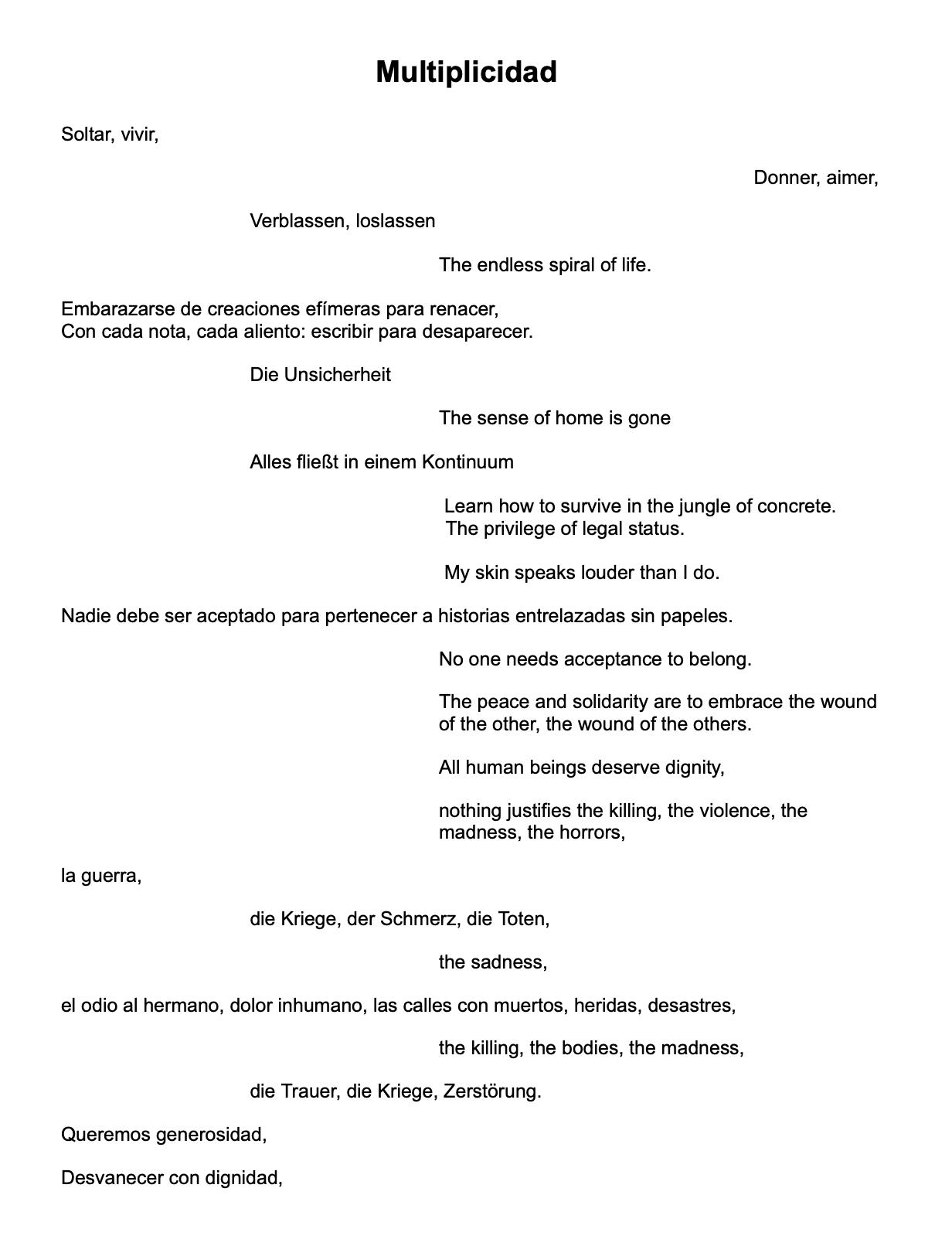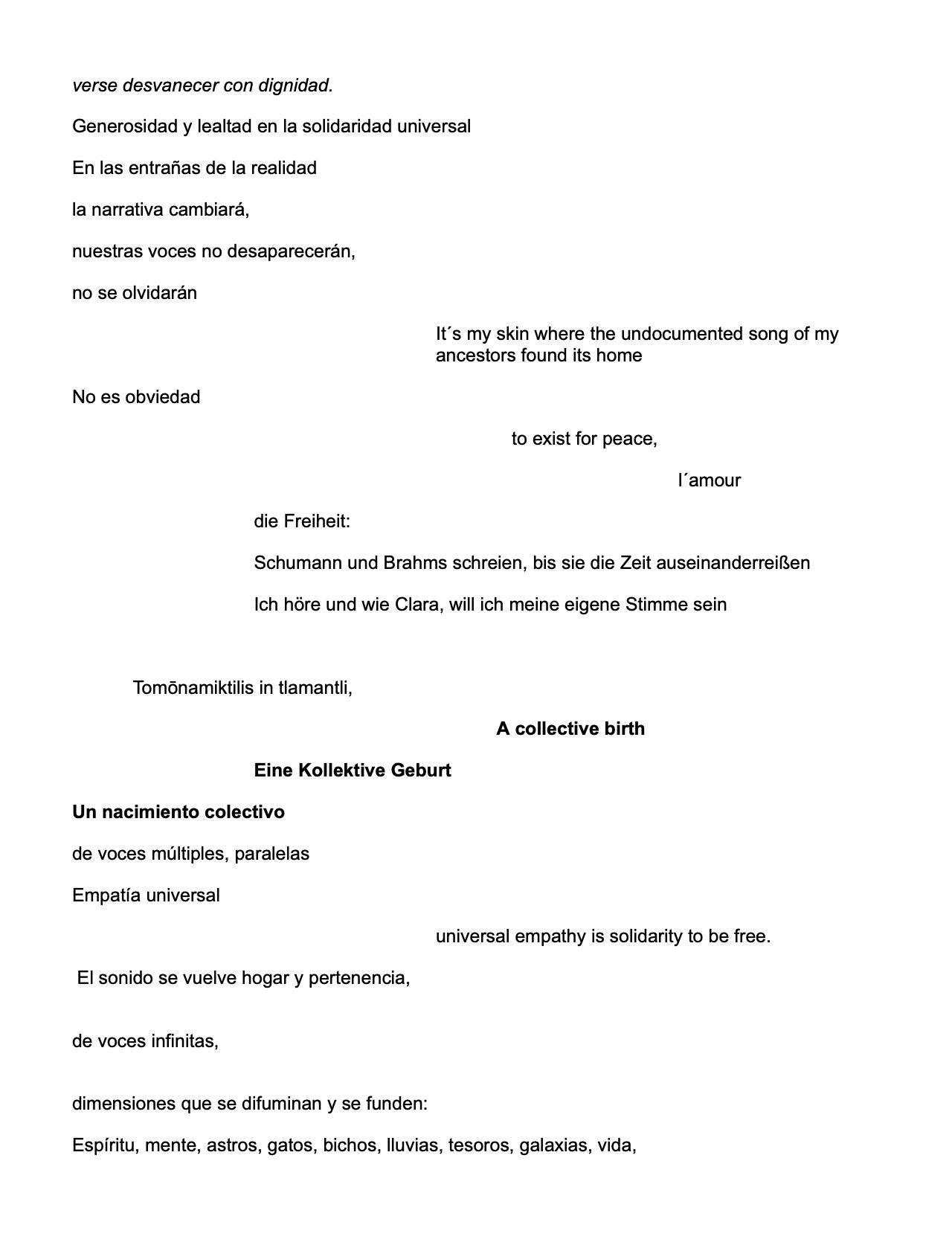Multiplicidad Diana Syrse
For voice and orchestra 2025
Score


For voice and orchestra 2025
Score

Instrumentation
2 Flutes / 1era muta Piccolo
2 Oboes
1 Clarinet in Bb
1 Bass Clarinet
2 Bassoons
4 Horns in F
2 Trumpets in C
1 Tombone
2 Bass Trombones
1 Tuba
Timpani
4 Percussionist
Piano Voice
Strings
Percussion 1
Gran Cassa
Tam tam
1 Metal sheet
Medium gong
Low bongo
High bongo
Floor tom
Tom 1, tom 2
High and low woodblock
Hi-hat
Ride
Medium cymbal
Windchimes
Crotales (2 octaves)
Death whistle
Marimba
Percussion 5
Four timpani
Notes
Percussion 2
Gran cassa
Tam tam
1 death whistle
2 congas
Suspended
Medium cymbal
Metal coil
Maracas
Vibraphone
Technical requirements:
It is necessary to provide one wireless lavalier microphone (microport) to amplify the singer’s voice, as well as four stage monitors: one for the singer, one for the conductor, and two for the orchestra.
It is also strongly recommended to have a professional audio technician present at every rehearsal and performance.
Percussion 3
Gran Cassa
Tam tam
Small gong
Medium gong
Floor tom
Snare drum
Tom 1, tom 2
Hi-hat
Guiro
1 death whistle
Waterphone
(with a contrabass bow)
Anvil
Percussion 4
Gran Cassa
Tam tam
Medium gong
Floor tom
Tom 1, tom 2
High and low woodblock
Hi-hat
Ride
Medium cymbal
Windchimes
Crotales (2 octaves)
Death whistle
6 Bottles made of glass of different sizes
This work was commissioned by the Philharmonic Orchestra of Bremen, featuring Diana Syrse as soloist, under the direction of Marko Letonja. Premiere on September 21, 2025, at Die Glocke in Bremen. The text was written by the composer herself. This work is dedicated to Laurent Vilarem.
Duration: 10''20'' apx.
Transcribed from the manuscript, with score and parts edited and prepared by Erick Tapia.
Extended Techniques
General:
Accidentals apply within the measure in which they appear, unless canceled by another accidental sign, or tied into a following measure. If a note has an accidental and the note is repeated in a different octave within the same measure, the accidental does not apply to the same note of the different octave.
Voice
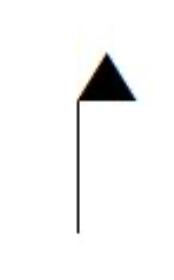
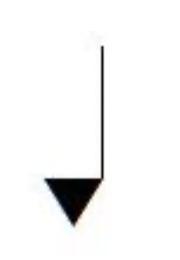


Winds

Strings

Highest possible note
Lowest possible note
Sprechgesang
Whisper





High Medium
Low
Vocal fry
Random note
Improvise freely
Free improvisation
Use of: chest voice, belt voice, bel canto, nasal voise as well as different kinds of vibrato
Air sound: use the fingering needed to produce the marked pitch; however, do not produce the normal tone but just blow air through the instrument
Half pitch-half air: use the fingering needed to produce the marked pitch; produce the normal tone blowing air through the instrument producing half-air, half-pitch
Indicates a move from normal sound to scratch sound (overpressure)
Triangle noteheads indicate a very high pitch on any given string.
(While this notehead typically indicates the highest possible pitch on any given string, for practical purposes in this work it means any pitch far up the fingerboard.)
m.s.p. molto sul ponticello bow placement, as close to the bridge as possible without being on it
µ Quarter tone, between natural and sharp
B Quarter tone, between natural and flat
Pizzicato with muted strings
Overpressure
Percussion

!
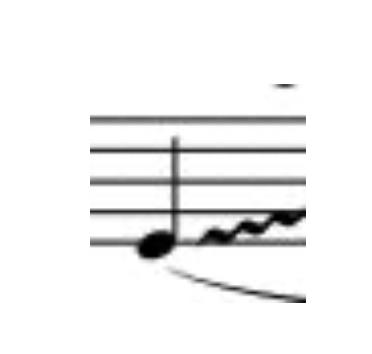
Wind sound (only air)
Put pressure against the gran cassa/tam tam making semi-circles slowly on the front part of the instrument with a short superball friction mallet (create low and high tones). Variate the velocity and pressure (Whale sound)
Scrape the tam-tam surface with a triangle beater
Note for the death whistle: Uncover the death whistle hole with your palm for every accent marked on the score. For long notes, uncover the hole. Breathe when needed to sustain the notes.
